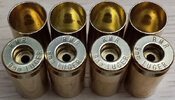When RMR decided to sell their own headstamp branded 9mm brass, I thought it would be good to update the "
Myth Busting Neck Tension and Bullet Setback" thead with RMR and other newer headstamp brass like SIG (Sig Sauer)/DRT (Dynamic Research Technologies)
So when I received the RMR branded 9mm brass order, I start data collection for part 2 of "neck tension and bullet setback" and measure 9mm brass at 4 points (12/3/6/9 o'clock) with additional headstamp brass to include RMR at .100"/.200" below case mouth.
But after data collection over several weeks part time after doing wife's "Honey Do" list of project chores, I get ready to do bullet setback test using Glock 22/23 and KKM conversion barrel I previously used and my darn Chromebook decides to do an update and BAM ... my new thread data is GONE.

(I should have backed up the draft data on Google cloud ...

)
So stay tuned as I redo another myth busting thread on neck tension and bullet setback.
BTW, I was able to post initial measurements of new RMR headstamp 9mm brass on the "Best 9mm brass" thread compared to Starline brass measurements for comparison (Only new data saved due to THR posting ... And FYI, I already asked
@longdayjake if Starline made RMR brass and answer was "No") -
https://www.thehighroad.org/index.php?threads/best-9mm-brass.918907/page-2#post-12642215
Thickness .100" below case mouth where taper crimp is applied:
RMR: .011"/.011"/.011"/.012"
RMR: .011"/.011"/.012"/.012"
RMR: .011"/.012"/.012"/.012"
Starline: .011"/.011"/.012"/.011"
Starline: .013"/.011"/.010"/.011"
Starline: .010"/.011"/.011"/.011"
Thickness .200" below case mouth where 115 gr FMJ bullet base gets seated down to:
RMR: .012"/.012"/.012"/.013"
RMR: .012"/.012"/.013"/.013"
RMR: .012"/.013"/.013"/.013"
Starline: .012"/.012"/.013"/.012"
Starline: .012"/.013".012"/.011"
Starline: .012"/.012"/.013"/.013"




